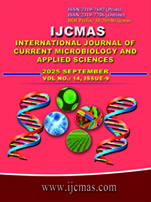


 National Academy of Agricultural Sciences (NAAS)
National Academy of Agricultural Sciences (NAAS)

|
PRINT ISSN : 2319-7692
Online ISSN : 2319-7706 Issues : 12 per year Publisher : Excellent Publishers Email : editorijcmas@gmail.com / submit@ijcmas.com Editor-in-chief: Dr.M.Prakash Index Copernicus ICV 2018: 95.39 NAAS RATING 2020: 5.38 |
With the intervention of green revolution many of the high yielding varieties, pesticides and fertilizers were introduced in agriculture which resulted in gradual replacement of traditional agricultural practices to chemical farming but, the chemical farming not only deteriorated the soil health. In order to overcome the effects of the chemical farming, the biological means of crop production is gaining lot of importance. Among the biological means, the endophytic microorganisms are a class of microbes that live in internal plant tissues of apparently healthy host plant parts like roots, stems, leaves and seeds which play an important role in growth and development of the crop by nutrient solubilization, biological control and production of phytohormones. So far, the crop endophytes have been exploited more but, the weed endophytic bacteria are not concentrated much in crop production. Hence, there is a need to give attention on the use of the weed endophytic bacteria in agriculture. In an attempt to isolate, screen and characterize the plant growth promoting endophytic bacteria from roots and stems of selected weed species which are grown in cultivated areas of Shivamogga district, Karnataka, India. Out of 5 weed species, as many as twenty seven endophytic bacterial isolates were obtained and assessed for their plant growth promotional activities viz., phosphorus, potassium, zinc and silicon solubilization. Among 27 endophytic bacterial isolates tested, four isolates viz., SENDO – 5, SENDO – 6, SENDO – 17 and SENDO – 27 were efficient in phosphorus, potassium, zinc and silicon solubilization ability. Further, based on morphological and biochemical characters the efficient endophytic bacterial isolates were tentatively identified as Achromobacter and Citrobacter species. Scaleup studies are required to develop and evaluate the different formulations of the efficient endophytic bacterial isolates on different crops for their sustainable production.
Anonymous, 1957, Manual Microbiol. Methods. McGraw. Hill Book Company Inc., New York, p.127.
Barthalomew, J.W. and Mittewer, T., 1950. A simplified bacterial strain. Stain Tech, 25, p.153.
Fadiji, A.E., Ayangbenro, A.S. and Babalola, O.O., 2023. Draft genome sequence of Citrobacter freundii AYS58, a potential plant growth-promoting endophyte. Microbiology Resource Announcements, 12(5), pp.e00142-23.
Hardoim, P.R., Van Overbeek, L.S., Berg, G., Pirttilä, A.M., Compant, S., Campisano, A., Döring, M. and Sessitsch, A., 2015. The hidden world within plants: ecological and evolutionary considerations for defining functioning of microbial endophytes. Microbiology and molecular biology reviews, 79(3), pp.293-320.
Hongrittipun, P., Youpensuk, S. and Rerkasem, B., 2014. Screening of nitrogen fixing endophytic bacteria in Oryza sativa L. Journal of Agricultural Science, 6(6), p.66.
Jha, P. and Kumar, A., 2009. Characterization of novel plant growth promoting endophytic bacterium Achromobacter xylosoxidans from wheat plant. Microbial ecology, 58(1), pp.179-188.
Kumar, A., Meena, S.K., Sinha, S.K., Singh, A.K. and Singh, S.K., 2023, Isolation and biochemical characterization of endophytic bacterium Gluconacetobacter diazotrophocus from native sugarcane cultivar of middle Gangetic plains of India. Indian Journal of Ecology, 51(1), pp.104-112.
Ledin, M., Krantz-Rülcker, C. and Allard, B.J.S.B., 1996. Zn, Cd and Hg accumulation by microorganisms, organic and inorganic soil components in multi-compartment systems. Soil Biology and Biochemistry, 28(6), pp.791-799.
Liu, D., Lian, B. and Dong, H., 2012. Isolation of Paenibacillus sp. and assessment of its potential for enhancing mineral weathering. Geomicrobiology Journal, 29(5), pp.413-421.
Mehboob, I., Rajput, L., Mubeen, F., Hafeez, F.Y., and Malik, K.A., 2022, Endophytic bacteria associated with cereals enhance silicon solubilization and plant stress tolerance. Rhizosphere, 21: 100456.
Oteino, N., Lally, R.D., Kiwanuka, S., Lloyd, A., Ryan, D., Germaine, K.J. and Dowling, D.N., 2015. Plant growth promotion induced by phosphate solubilizing endophytic Pseudomonas isolates. Frontiers in microbiology, 6, p.745.
Panse, V.S. and Sukhatme, P.V., 1985, Statistical Methods for Agricultural Workers, Indian Council of Agricultural Research, New Delhi, pp. 152-155.
Rangaswami, G., 1975, Diseases of Crop Plants in India. Prentice Hall (P) Ltd., New Delhi. p. 520.
Sharma, S.B., Sayyed, R.Z., Trivedi, M.H. and Gobi, T.A., 2013. Phosphate solubilizing microbes: sustainable approach for managing phosphorus deficiency in agricultural soils. SpringerPlus, 2(1), p.587.
Singh, R., Prasanna, R., Sharma, S. and Nayyar, N., 2022, Zinc-solubilizing endophytic bacteria from cereals: mechanisms and biofortification potential. Applied Soil Ecology, 170: 104297.
Steel, R.G.D. and Torrie, J.H., 1960, Principle and Procedure of Statistics. McGrow Hill Book Company, Inc., London.
Strobel, G. and Daisy, B., 2003. Bioprospecting for microbial endophytes and their natural products. Microbiology and molecular biology reviews, 67(4), pp.491-502.
Sultana, S., Mushtaq, A., Bashir, S., Ali, S. and Mehnaz, S., 2021, Endophytic zinc-solubilizing bacteria: a sustainable approach for improving zinc nutrition in staple cereals. Journal of Applied Microbiology, 131(4), pp.2000–2012. |
 |
 |
 |
 |